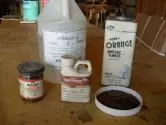Refinished vs. Original Finish: What To Do?

But from there the waters can get a little murky.
Should you buy a refinished piece?
How much less should you pay? 25%? 50%? 75%?
Does refinishing it again lessen the value even more?
We can blame the fact that many Arts and Crafts antiques no longer have their original finish on at least three factors. First, those early varnish and shellac finishes were neither as stable nor as durable as today’s finishes, prompting many of them to wear away or darken over the years. Second, the do-it-yourself refinishing era ushered in with the country’s bicentennial celebration in 1976 sent many people out looking for projects to strip, sand and refinish into the then-popular Golden Oak. And third, Arts and Crafts furniture remained inexpensive for decades, making it an ideal candidate for painting and refinishing.
While living in Iowa City in the 1970s, I purchased over the phone a Gustav Stickley dropleaf table from a delightful older lady who lived several miles away and who had mailed me a photograph of it. We agreed on a price and a pickup time the following Saturday. When I arrived I found a Golden Oak version of a Craftsman dropleaf table. “You were so nice on the phone,” she exclaimed, “that I decided to refinish it for you.”
While I no longer have that particular table, the majority of the pieces in my home have been refinished. Early in my career as a professional refinisher and struggling writer, I did not have the luxury of keeping any rare, pristine examples of Stickley or Roycroft furniture I discovered. I had workshop rent due the first of every month, a mortgage on my house, a delivery van payment, employees to pay and expenses to cover. I established a basic rule: I could only keep those pieces I had paid for with money I made from the ones I sold.
And so I kept the refinished ones, restoring them as close as possible to their original appearance before taking them home.
So, does a second refinishing decrease the value even more?
Not in my book.
Removing a sloppy, glossy new finish, along with any leftover sanding scratches, and replacing it with an appropriate dye, stain or fumed color and finish, along with the correct upholstery material, will increase the value of a previously refinished antique. While it won’t equal that of an original finish, it will be a step closer.
And how much of a deduction should be made for a refinished surface? Well, it depends on the piece. An extremely rare form will not have as great a deduction for being refinished than a more common form will, simply because collectors know they may never have the opportunity to find the rare form again in any condition.
A great deal also depends on the quality of the refinishing. If it has been done properly and will not require the additional investment of a proper restoration, then only a minor deduction of perhaps 25% has some support.
We also recognize that collectors may fall into two different camps: those that will only accept original condition and those who value the form (and the reduced price) more than the original finish. I can confess, too, that when my cat Percy scratches a new finish I applied, I don’t wince as loudly as I would had the finish been original, for I know I can fix it without harming its value.
Veteran Arts and Crafts dealers Gene and Jody Zwiefel (http://www.webteek.com/kindredstylesantiques) offered this advice for collectors, including those heading to the Grove Park Inn in a few weeks. “Our advice to collectors is to buy what appeals to them in regards to form, function and budget. Furniture is to be used and enjoyed in your home. There are some beautiful, properly refinished pieces available on the market. We encourage collectors to discuss their prospective purchase with the seller, as a reputable dealer will be the best teacher.”
With a declining number of galleries that stock Arts and Crafts antiques, shows such as the Grove Park Inn, as well as the Chicago and Twin Cities shows, provide collectors with a great opportunity to study both forms and finishes, and to take advantage of the collective wisdom gathered in one room for just a few days a year.
– Bruce Johnson

